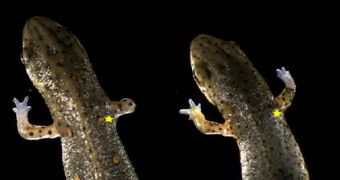Up until now, humans were able to regenerate limbs only in science fiction and children movies. But for a salamander, this is as simple as for a lizard to regenerate its tail, a trait that has fascinated humans for a long time, but which has remained unexplained.
Now, a new research shows that one molecule could be the factor enabling these amphibians to sprout back their arms, a hope for the domain of human regenerative medicine. By now, researchers only know that a chemical encountered in pig bladder can boost tissue regeneration: in one case, the chopped tip of a finger regenerated within six weeks, but only partially.
The new research published in the Nov. 2 issue of the journal Science found that nAG protein boosted the multiplication of stem cells that ultimately generate new limbs in red-spotted newts (Notophthalmus viridescens), a salamander species. When the newt loses a limb, local cells experience de-diffentiation to stem cells, which form at the tip of the stump left by the limb a mass of cells named blastema. "Those cells grow and divide and they give rise to the structures that have been amputated. So if you amputate at the wrist, those cells will give rise to a hand; if you amputate at the shoulder, they'll give rise to an arm.", said co-author Jeremy Brockes of the University College London.
The team amputated the red-spotted newts' limbs and then attached the nerves. Nerves are essential for triggering the synthesis of the nAG protein. Then they stimulated the stumps with electrical pulses so that the tissues could release DNA comprising genes for the protein nAG.
30 to 40 later, the newts had regrown their lost limbs completely, digits included, but with a lower muscle mass than the normal limbs. Further investigation showed that the nAG protein stimulates directly the blastema cells, leading to the development of the new limbs. "It essentially tells us that one single molecule is able to support the proliferation of blastema cells right from the start of regeneration all the way through to the formation of the digits. Several other growth factors are known to stimulate the proliferation of blastema cells, though these molecules haven't been tested rigorously like in the recent study. ", said biologist David Stocum of Purdue University in Indiana, not involved in this research.
But humans may have a different regenerative mechanism. "If you can make those cells de-differentiate, then you've got to make them divide to produce a blastema, and nAG would be a molecule that you could use to make that happen", Stocum told LiveScience.
"What everybody is interested in, of course, are things about the extension to humans. I'm really very cautious about that," Brockes told LiveScience. "In order to move human limb regeneration forward scientists need to figure out if there is a human equivalent to the blastema that salamanders form after a limb gets amputated. I don't think we generate those [blastema] cells after injury in a way that a newt does", Brockes added.

 14 DAY TRIAL //
14 DAY TRIAL //